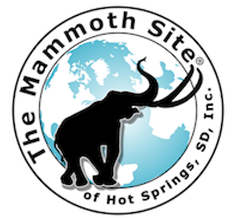History
In June 1974, heavy equipment operator George Hanson was leveling ground for a Hot Springs housing development planned by landowner Phil Anderson. Hanson was grading a small hill when his blade struck something that shone white in the sunlight. Hanson got out for a closer look. What he saw was a tusk, about seven feet long, sliced in half length-wise, along with other bones. Mr. Anderson contacted three universities and colleges in South Dakota and one university in Nebraska; none of the 4 colleges were interested in the project nor did they have any desire to come and see what was discovered in Hot Springs.
Mr. Hanson then took some of the bones to his son Dan, who had taken classes in geology and archaeology. Dan Hanson realized these were no ordinary bones. He called his former college professor, Dr. Larry Agenbroad, who was on the faculty of Chadron State College in Chadron, Nebraska at the time, and asked him to come and take a look at the site. Dr. Agenbroad was in southeastern Arizona when Hanson called, excavating a site where mammoths had been hunted and killed.
The young Hanson kept a 24-hour vigil at the site until Dr. Agenbroad and his crew could arrive. Dr. Agenbroad’s first look at the number of bones exposed by the bulldozer told him there were at least four to six mammoths. He knew there had to be more.
Because of another commitment at the Hudson-Meng Bison kill site near Crawford, NE, Dr. Agenbroad asked his colleague Dr. Jim Mead and several members of his Arizona dig crew to spend 10 days salvaging and stabilizing the bones, tusks, teeth, and skull fragments that had been exposed. Land owner, Phil Anderson, offered to halt his housing project until they had a better handle on what was there. This short excavation proved significant, as an unprecedented number of specimens were uncovered.
The following year, in 1975, Dr. Agenbroad and Dr. Mead led a team of volunteer students to begin excavating the site. Interest in the mammoth graveyard grew rapidly after a complete skull with tusks intact was unearthed. They would dig in the summer months and rebury in the winter to preserve them.
By the end of the 1975 summer excavation, Phil Anderson realized his 14 acres of land would be more valuable as a resource for scientific study rather than a housing development. Soon thereafter, through community commitment and Mr. Anderson’s generosity, the Mammoth Site of Hot Springs, SD, Inc., a 501 (c)(3) Non-Profit Organization, was born.
“The community of Hot Springs keeps one of the most valuable fossil treasures known to mankind today.”
Dr. Ralf-Dietrich Kahlke
Professor, Germany
